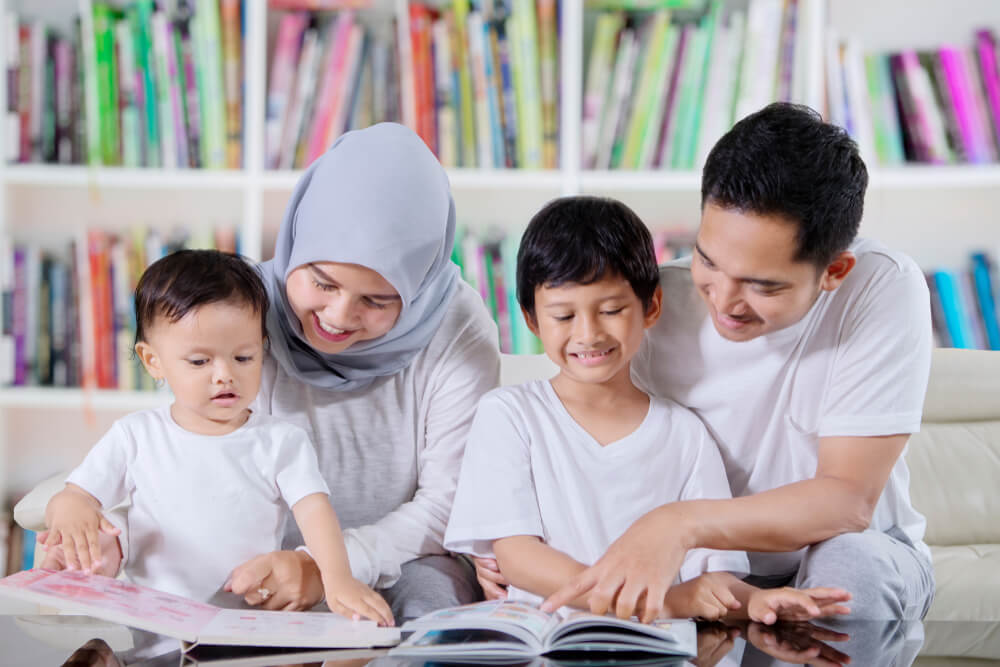
6 Questions to Help You Set Up Your Family Home Library
Reading together is crucial for developing language and literacy skills and a love of learning! Children learn best through social interaction and what better way to foster those positive relationships than sharing a story? While you’ll definitely want to connect with your local public library to expand your access to quality books, here are some questions to ask yourself as you build your home library of favorites:
1) What’s award-winning?
The American Library Association presents dozens of children’s book and media awards each year, including the Caldecott Medal for distinguished American picture books, the Coretta Scott King Book Awards for outstanding books for young adults and children by African American authors and illustrators that reflect the African American experience, and the Robert F. Sibert Informational Book Medal for distinguished informational books for children. Find out more about the ALA awards and see current and historical award lists here.
In addition, many states have their own book awards, many of which are voted on by kids themselves! Find your state award in this Vanderbilt University research guide.
2) What’s popular?
Popularity isn’t everything, but sometimes following the crowd can lead to some great reads! Check out the New York Times Best Sellers in Children’s Picture Books to see what’s hot. Better yet, contact your local independent bookstore and ask a bookseller for personalized recommendations!
3) What’s unique to your family?
All children deserve to see themselves reflected in the books they read. Making connections between books and a child’s own experience fosters language, literacy, and social skills. Look for books that depict characters and situations familiar to your family. Check out this massive searchable list of themes from Reading Rockets to find recommended titles reflecting many different topics and backgrounds.
4) What’s appropriate?
When selecting books for reading together, there’s no need to worry about reading level; in fact, you’ll probably notice that picture books, which are meant to be read aloud, often have much more sophisticated vocabulary and sentence structure than children’s books meant for independent reading. That’s because kids need to be exposed to more challenging language even if they are reading at a beginning level—or not reading yet at all! When choosing books to read with your beginning reader, you may wish to choose a mix of titles, some easy enough that they can read to you, and some that you will read to them.
Want to find out more about the content of a book before buying it? Check out Book Riot’s roundup of children’s book review sites.
5) What’s coming up?
Books can help children process their current reality, but they can also help prepare them for what’s to come. Whether it’s starting kindergarten, welcoming a new baby, or learning to ride a bike, tender topics processed through the lens of a story can make life events less scary. Find recommended titles on every topic from potty training to dealing with discrimination at this subject guide from Ivy Tech Community College Libraries.
6) What’s missing?
While it’s important for all children to see themselves in the pages of the books they read, it’s also vital that they see people of all different backgrounds. This is especially important if they live in a homogenous area. Learning about other ways of thinking and being through books helps children develop empathy.
As Dr. Rudine Sims Bishop wrote, “Books are sometimes windows, offering views of worlds that may be real or imagined, familiar or strange. These windows are also sliding glass doors, and readers have only to walk through in imagination to become part of whatever world has been created and recreated by the author. When lighting conditions are just right, however, a window can also be a mirror. Literature transforms human experience and reflects it back to us, and in that reflection, we can see our own lives and experiences as part of the larger human experience.” (Sims Bishop, R. (1990). Mirrors, Windows, and Sliding Glass Doors. Perspectives, 1(3), ix-xi.)
So take a look at your collection with an eye to what’s missing. Whose voices aren’t being heard? Then check out these excellent resources from We Need Diverse Books to expand your home library.
A successful home library reflects the joys and challenges of your family! Every turn of those well-worn pages is creating positive associations with the printed word for your child and deepens your relationship.
Kathy MacMillan (she/her) is a writer, nationally certified American Sign Language interpreter, librarian, and signing storyteller. She is the co-author (with Manuela Bernardi) of She Spoke: 14 Women Who Raised Their Voices and Changed the World, and the author of Nita’s First Signs, Nita’s Day: More Signs for Babies and Parents, The Runaway Shirt, and many more books for children, teens, and adults. Find her online at https://kathymacmillan.com/.
